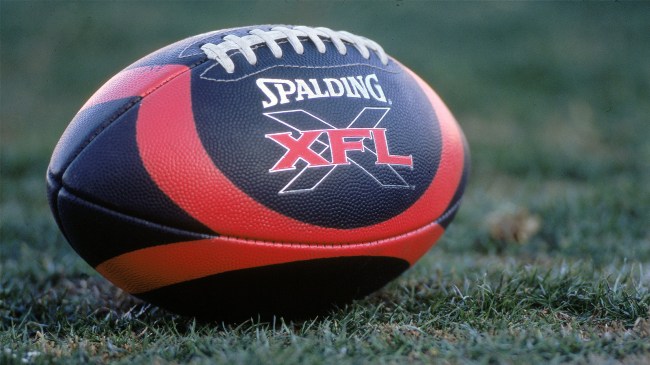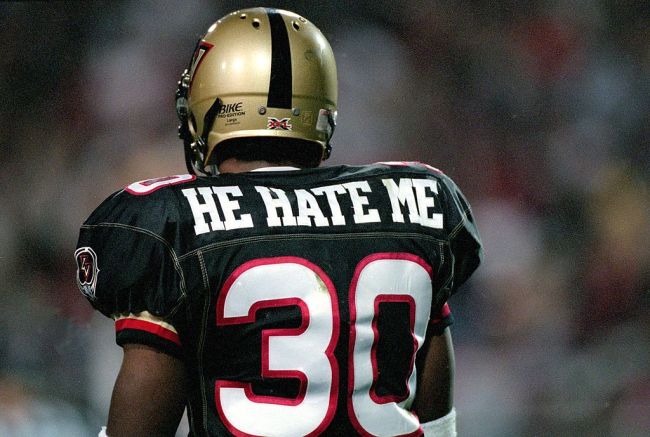
Getty Image
On Thursday, the XFL will set out to test the theory that the third time is the charm when the league comes back from the dead yet again after being revived by Dwayne Johnson and the other investors who purchased its remaining assets for $15 million in 2020.
The XFL will officially reboot when the Vegas Vipers and the Arlington Renegades face off on Saturday afternoon to continue a saga that stretches back more than 20 years.
If you’re familiar with the XFL, you’re likely aware the first iteration was the end result of Vince McMahon and (what was then known as) the WWF’s decision to attempt to capitalize on America’s appetite for football by teaming up with NBC to introduce the world to the upstart league that made its grand debut a week after Super Bowl XXXV in 2001.
The first XFL game was played on February 3rd of that year to kick off a campaign that wrapped up when the championship dubbed the “Million Dollar Game” was held on April 21st. Unfortunately, the XFL’s first season would also be its last, as the league lost a whopping $70 million before the powers that be opted to cut their losses.
The bar for success was subsequently set very, very low when McMahon and (what is now known as) the WWE revived it in 2020. However, the company couldn’t have picked a worse time to attempt to mount a comeback, as the XFL 2.0 only made it five weeks before it was permanently shut down due to the pandemic.
There’s no telling how the XFL will fare with Johnson and Co. at the helm, and while history may not be on their side, it is worth noting the league actually managed to have a more lasting legacy than you might think at first glance thanks to a few contributions that show it was actually fairly ahead of its time.
How the XFL helped alter the football landscape

Getty Image / Todd Warshaw/Allsport
There are certainly a number of supposed “innovations” the XFL introduced in its inaugural season that have not exactly stood the test of time.
For example, it didn’t take long for the decision to replace the opening kickoff with an “opening scramble” to come back to bite the league, as a member of the Orlando Rage ended up with a separated shoulder while trying to get possession on the XFL’s first-ever day of action.
The XFL also attempted to Disrupt the traditional football with the custom black pigskin it whipped up in conjunction with Spalding, but they were smooth to the point where equipment managers had to rub them with sandpaper to make them easier to throw, catch, and hold onto while running.
With that said, the XFL was still ahead of the curve on a number of fronts.
What is probably the most impactful aspect of the league’s legacy had less to do with the product on the field but rather the technology and equipment used to capture it.
The “Sky Cam” had been harnessed by other sports prior to the inaugural season in 2001, but it became impossible to ignore thanks to NBC’s decision to prominently feature the sweeping shots captured from the camera hanging over the field. That perspective is now a staple of NFL broadcasts to the point where it’s hard to remember what it was like to watch a game before they were introduced.
As I alluded to while discussing the opening scramble, safety wasn’t necessarily a huge priority in the XFL (after all, we’re talking about a league that really stressed the elimination of the fair catch rule while marketing its games). With that said, it was surprisingly progressive when it came to its stance on the turf the game was played on.
When the XFL was still deciding on the cities and venues that would host games, it mandated every stadium where the contests were held had to feature natural grass as opposed to artificial turf. While aesthetics certainly played a role in that decision, player safety was also taken into consideration (a facet the NFL continues to downplay despite ample evidence highlighting the downsides).
The XFL also beat the NFL to the punch when it came to its approach to extra points. The league eliminated the post-touchdown kick entirely in favor of a mandated one-point conversion, which stemmed from the belief splitting the uprights after a TD was a forgone conclusion (the NFL would address that issue when it increased the distance for XPs ahead of the 2015 season).
While allowing players to put nicknames on the back of their jerseys was (sadly) a trend that failed to catch on, I’d be remiss if I didn’t mention the lasting impact of Rod Smart, the Las Vegas Outlaws running back you likely know better as “He Hate Me.” There’s no evidence Smart (and other XFL players) inspired Chad Johnson to legally change his last name to “Ochocinco” in 2008, but I find it very hard to imagine the alternate monikers didn’t play a small role.
Will the XFL 3.0 manage to leave any similar marks when everything is said and done? I guess we’ll just have to wait and see.
RELATED: NFL Fans Laugh As Bountygate Orchestrator Gregg Williams Highlights List Of XFL Coordinators